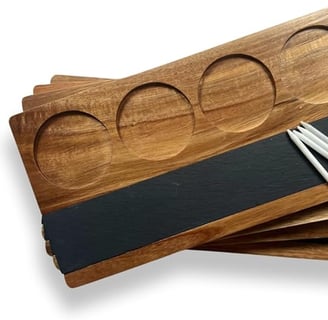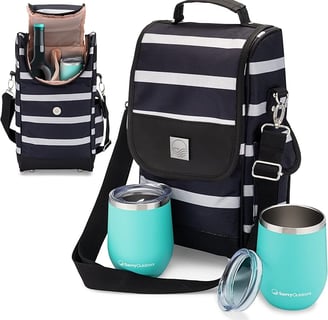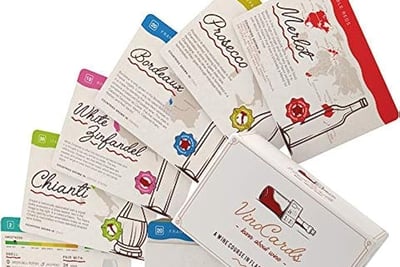Creating an Unforgettable At-Home Wine Tasting Date
8 min read


Introduction to At-Home Wine Tasting
Hosting an at-home wine tasting date presents a unique and pleasurable way to explore the rich flavors and aromas of various wines, all from the comfort of your own home. This casual yet meaningful experience allows you to relax, enjoy quality time with a partner or friends, and expand your palate without the need to venture out to crowded restaurants or wine bars. The ease of enjoying this experience in your personal space cannot be overstated, as it provides a cozy atmosphere conducive to both relaxation and engagement.
One of the appealing aspects of at-home wine tasting is the convenience it offers when selecting wines. You may already have bottles of wine in your collection, or you can easily acquire new options from nearby retailers, such as Trader Joe's, which often provides a variety of affordable and interesting wines. This accessibility means you can curate a selection that matches your taste preferences, whether you prefer bold reds, crisp whites, or sparkling options. By choosing wines that intrigue both you and your companions, you not only initiate engaging conversations but also aid in the discovery of new favorites.
In addition to its convenience and comfort, at-home wine tasting is a fantastic opportunity to bond with your partner or friends. Sharing thoughts on each wine, discussing its characteristics, and comparing flavor notes can lead to enriching conversations and unforgettable moments. This enjoyable activity fosters connections, encourages laughter, and allows everyone to take part in a shared adventure, unlocking the myriad flavors that wine has to offer. From a casual sip to a more structured tasting experience, the atmosphere you create will enhance the enjoyment of this intimate gathering.
Selecting the Perfect Wines
When creating an unforgettable at-home wine tasting date, the selection of wines plays a pivotal role in crafting the experience. For those who wish to explore their existing collection, it is beneficial to evaluate the bottles you already have on hand. Look for a variety of wine types, including reds, whites, and rosés, which can cater to different palates and enhance the overall tasting experience. Consider organizing a lineup that showcases diverse flavors and profiles, allowing each wine to complement or contrast with the others.
If your pantry is limited or you'd like to introduce new selections, purchasing wines can be an exciting activity in itself. One popular and budget-friendly option is 'Two Buck Chuck' from Trader Joe's, which offers an approachable way to experiment with different varietals without a significant financial investment. This brand has garnered attention for its affordability and decent quality, making it an ideal choice for an at-home tasting.
In selecting wines, consider thematic pairings that might unify the tasting experience. For example, you could choose wines from a particular region, focusing on a vineyard in Italy or a collection of Californian varietals. Alternatively, you could create a blind tasting with different styles from various places. For red wines, selections such as Cabernet Sauvignon or Pinot Noir will provide robust and intriguing flavors, while whites like Chardonnay or Sauvignon Blanc can offer refreshing contrasts. Rosés can be included for a light, versatile option that appeals to many preferences.
As you finalize your wine list, think about including a sparkling option, as this adds a celebratory touch to the evening. Ultimately, whether browsing your shelves or exploring your local wine shop, make your selections thoughtfully to ensure a delightful and memorable tasting experience.
Wine Tasting Setup: Creating the Right Atmosphere
Creating an inviting atmosphere is crucial for an enjoyable at-home wine tasting experience. The right ambiance sets the stage for relaxation and encourages conversation, making the evening memorable for both hosts and guests. Begin by selecting a dedicated tasting area. This could be a well-set dining table or a cozy corner in the living room, ideally free from distractions. The space should comfortably accommodate all participants, allowing for easy access to wine bottles and glasses.
Lighting plays a significant role in establishing the mood for your at-home wine tasting. Opt for soft, warm light rather than harsh overhead fixtures. Dimming the lights or using table lamps can create a cozy feel. For an added touch, consider incorporating candles. Their flicker not only enhances the overall atmosphere but also adds a sensory layer to the wine tasting experience through their subtle scents. String lights or fairy lights can add a whimsical element, transforming an ordinary space into an enchanting setting.
Music should not be overlooked. Choose a playlist that is soothing and unobtrusive, allowing conversations to flow freely without distraction. Instrumental or jazz music can be ideal, providing a backdrop that complements the experience without overpowering it. You can even curate a list of songs that evoke certain memories or feelings associated with wine to stimulate interesting discussions during the tasting.
Finally, consider adding decorative elements that align with the theme of the tasting. Fresh flowers, elegant tableware, and carefully curated wine accessories can all enhance the visual appeal of the setup. The overall goal is comfort and elegance, making your space feel special and tailored to the occasion. By setting the right atmosphere, you ensure that the at-home wine tasting becomes an unforgettable experience for all involved.
Pairing Wines with Snacks: Essential Nibbles
Wine tasting at home can be significantly enriched by thoughtfully pairing wines with complementary snacks. Understanding the intricacies of food pairings serves to enhance both the flavor of the wine and the tasting experience overall. The right combination can elevate tasting sessions from merely enjoyable to truly memorable.
To start, cheese is a classic companion for wine. Different varieties harmonize with specific wines, creating delightful contrasts or harmonious blends. For example, a rich, creamy Brie pairs beautifully with a light Chardonnay, while a sharp, aged Gouda complements the boldness of a Cabernet Sauvignon. The creaminess of the Brie can accentuate the wine’s acidity, whereas the Gouda’s nuttiness can soften the intensity of the Cabernet.
Nuts also serve as versatile snacks that can enhance the wine experience. Almonds or walnuts, especially when lightly roasted, offer a subtle crunch that adds texture. For instance, pairing a sparkling wine, like Prosecco, with salted almonds can amplify the effervescence of the wine, highlighting its vibrant characteristics. Similarly, pairing a robust red wine with spiced nuts can balance the wine's tannins with the warmth of spices, creating a pleasurable taste sensation.
Beyond cheese and nuts, incorporating various appetizers can diversify your tasting experience. Charcuterie boards laden with cured meats, olives, and marinated vegetables can serve as a great foundation for a wine tasting. The saltiness of cured meats like salami can enhance the fruitiness in lighter reds, while the spices in chorizo might complement the structure of oak-aged whites. By combining different flavors and textures, participants can explore how each element interacts with the wines, leading to a fuller appreciation of both food and drink.
In choosing snacks for your at-home wine tasting, consider how each complements the selected wines. A well-curated selection of cheeses, nuts, and other appetizers not only enhances the flavors of the wine but also enriches the overall experience, making every sip more enjoyable.
The Tasting Process: How to Taste Wine Like a Pro
Tasting wine is an art that combines sensory evaluation and personal experience, transforming a simple beverage into an exquisite experience. The process begins with observing the color of the wine, where one can examine its clarity and hue. Each wine will exhibit a spectrum of colors, from deep reds to pale yellows, revealing details about the grape variety and its aging process. For instance, a younger red wine may display vibrant purple tones, while an aged red may take on brownish hues.
Once the wine's color has been appreciated, the next step is swirling. Gently twirling the wine in the glass allows it to aerate, releasing its aromatic components. This is where the experience becomes interactive. Participants can take turns swirling, giving everyone a chance to enjoy the emerging scents.
Next comes the sniffing phase, an integral part of the tasting process. With the glass held at a slight angle, participants should take a deep inhale, focusing on identifying distinctive notes. Aromas might range from fruity to earthy, and their articulation can be enhanced by discussing them with fellow tasters. Utilizing descriptive language can make the experience richer; for example, one might note hints of blackberry, vanilla, or even tobacco.
Finally, it is time to sip. Take a modest sip, letting the wine wash over the palate. Here, flavors will unfold, exposing layers that may include sweetness, acidity, tannins, and body. It is beneficial to compare palates and note how wines can vary significantly in taste. Encouraging participants to jot down their preferences and comments will further facilitate a sharing atmosphere, building engagement and making the wine tasting unforgettable.
Making it Fun: Games and Activities to Enhance the Experience
Creating a memorable at-home wine tasting date can be significantly enriched by incorporating engaging games and activities. These interactive elements not only foster a sense of camaraderie but also elevate the overall enjoyment of the experience. One popular activity is wine trivia, which encourages participants to test their knowledge about various wine regions, grape varieties, and tasting techniques. This game can spark engaging conversations and allow participants to share interesting anecdotes related to wine.
Another exciting option is a blind tasting challenge, where participants sample wines without knowing their identities. This activity can be both entertaining and educational, as it prompts testers to focus on the wine's aroma, flavor, and texture. Ultimately, the goal is to guess the varietal, region, or even the producer, which can lead to delightful competition and plenty of laughter. Additionally, blind tastings can help participants develop their palates and tasting skills.
Pairing challenges are another excellent way to amplify the fun of an at-home wine tasting. Participants can be tasked with pairing their selected wines with various snacks or homemade dishes, exploring the complexities of how food influences the flavor profiles of the wines. This not only stimulates creativity but also allows for dynamic discussions about personal preferences and unexpected pairings. By involving everyone in these activities, couples and groups alike can create memorable moments filled with joy and laughter, making the wine tasting an unforgettable experience.
Fostering an interactive environment through games and activities transforms an ordinary wine tasting into a lively event. Such engagements encourage communication and connection, making the evening not just about sampling wine, but about building lasting memories together.
Conclusion: Turning Wine Tasting into a Regular Tradition
As you conclude your exploration of creating memorable at-home wine tasting experiences, it is worth considering the benefits of establishing these occasions as a regular tradition in your life. The joy of discovering new wines together can significantly enhance your relationship and culinary capabilities. Each wine tasting opens up numerous opportunities to learn not only about the wines themselves but also about the stories behind them, including their regions of origin and the unique processes involved in their production. This shared journey of exploration fosters deeper connections and collaborative enjoyment.
One effective strategy to keep your at-home wine tasting fresh and stimulating is to set specific goals for future tastings. You might choose to focus on a particular varietal, for instance, exploring the nuances between different Cabernet Sauvignons or understanding the subtleties of various Sauvignon Blancs. Alternatively, planning tastings centered on geographical regions—such as Italian, French, or Californian wines—can bring a new level of excitement and challenge to your gatherings. Themes add an intriguing element; for example, a night dedicated to only organic or biodynamic wines can open dialogues about sustainability in wine production.
Regularly incorporating these wine tasting events into your calendar can transform a simple date night into an engaging and educational experience. It allows you and your partner to not only enjoy exquisite flavors but also to cultivate an appreciation for the art of winemaking. Furthermore, as you gain confidence and knowledge, you may find yourselves sharing your experiences with friends or family, expanding the tradition into a larger community gathering. Such interactions will enrich your life as you collectively celebrate each discovery.











